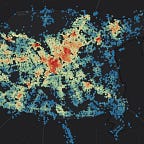Local centers and public places
Eliminating subjectivity bias in search of the places that matter to people.
Master plans often “don’t notice” local centers and public spaces that are created by small businesses or residents themselves. The reason for this is a lack of up-to-date information about people’s preferences and the situation on the ground, as well as bias within the administration, which may deem some activities as not prestigious enough for the city. This leads to chronic underinvestment in the places that are naturally popular, and results in a poor state of pedestrian infrastructure and urban landscape as a whole.
We suggest using strict criteria and data updated in real-time to reduce the influence of the subjective experience and identify places that are in fact of high importance for citizens.
Looking for activity centers using Google Maps points of interest
Minsk’s centers of city-wide and local significance are shown below. They are defined as places with the highest temporal density of Google maps points of interest (PoI). Results align with both professional and lived intuition, and at the same time have a rigorous basis behind them.
Local centers (northwest Minsk)
The relatively more prosperous area of northwest Minsk can be seen to the right. Most points-of-interest clusters are located along major highways and near metro stations. At the same time, the general density of the points is quite high, although it decreases on minor streets and inside microdistricts (housing estates or neighborhoods).
Local centers (Serebryanka)
Serebryanka, a relatively less-prosperous neighborhood, is shown to the right. Points of interest density is lower and they are concentrated along the central axis of this area. The closest significantly noticeable cluster is located outside the area at the metro station. Combined with the neighborhood’s low access to public transportation, fewer destinations offered means lower quality of life, especially on the periphery of this area.
The study of digital footprints of peoples’ presence and activity allows us to find out what they are doing in their life and not just what they say they would like to do. However, this circumstance is in itself a flaw, and should not be overlooked. Not everybody has good access to the internet and a mobile phone. This method makes it easier to find already existing destinations related to consumption. However, it is somewhat more difficult to see the potential of a given location (although not impossible) or to find out about people making uneasy compromises and wishing for something better.
Further analysis of the intersectional inclusiveness of local centers and the diversity of their destinations is possible. This would require a detailed study of the nature of public space, including mapping and uncovering gaps between what is desired/needed and what is available.
A project by: Eugene Kalinouski (link) and Dzmitry Bibikau (link)
